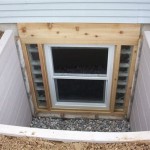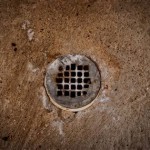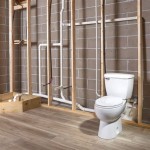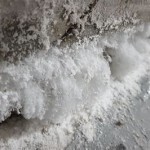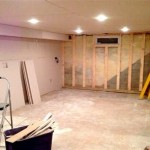How To Clean Cement Dust From Basement Floor
Cement dust in a basement is a common issue, particularly after construction or renovation projects. This fine, powdery residue can settle on surfaces, posing a health hazard and making the space look unclean. Effectively removing cement dust requires a systematic approach, utilizing the right tools and techniques to ensure a clean and safe environment. Failure to properly address cement dust can lead to respiratory irritation, skin allergies, and long-term damage to materials.
The composition of cement dust is primarily calcium silicates, aluminates, and ferrites, along with smaller amounts of other compounds. Exposure to this dust can cause various health issues, including eye irritation, nose and throat irritation, and respiratory problems. Long-term exposure may lead to more severe conditions, such as chronic bronchitis or silicosis, especially if the dust contains crystalline silica. Therefore, it is crucial to wear appropriate personal protective equipment (PPE) during the cleaning process.
Preparation and Safety Precautions
Before beginning the cleaning process, it is imperative to prioritize safety. Cement dust can be irritating to the eyes, skin, and respiratory system. Therefore, the first step is to equip oneself with the appropriate PPE. This includes a properly fitted N95 or P100 respirator mask to prevent inhalation of the dust. Safety glasses or goggles should be worn to protect the eyes from irritation and potential injury. Gloves, preferably heavy-duty work gloves, are necessary to protect the skin from prolonged contact with the dust, which can cause dryness and irritation. Long sleeves and pants are also recommended to minimize skin exposure.
Adequate ventilation is crucial to minimize the concentration of airborne dust particles. Open windows and doors to allow for airflow. If natural ventilation is insufficient, consider using a fan to circulate air and exhaust dust outside. However, be mindful of the direction of airflow to prevent dust from being blown into other areas of the house. Covering furniture and other belongings in the basement with plastic sheeting can prevent them from becoming contaminated with cement dust during the cleaning process. Secure the sheeting with tape to prevent it from shifting and exposing the items underneath.
Before introducing water or cleaning solutions, it’s crucial to perform a dry cleanup to remove the bulk of the cement dust. This prevents the dust from becoming a slurry, which can be more difficult to remove. A broom with soft bristles is suitable for sweeping large areas. Avoid brooms with stiff bristles, as they can stir up dust and make it airborne. A dustpan should be used to collect the swept-up dust. Dispose of the collected dust properly in a sealed bag to prevent it from escaping and contaminating other areas.
The Dry Cleaning Phase: Sweeping and Vacuuming
Sweeping the basement floor should be done systematically, starting from one corner and working across the entire floor. Use overlapping strokes to ensure complete coverage. Periodically empty the dustpan into a sealed bag to prevent the collected dust from becoming airborne. After sweeping, a vacuum cleaner equipped with a HEPA (High-Efficiency Particulate Air) filter is essential for removing the remaining fine dust particles. HEPA filters are designed to trap very small particles, including cement dust, preventing them from being recirculated into the air. Standard vacuum cleaners without HEPA filters may not be effective and can actually worsen the problem by spreading the dust further.
When vacuuming, use a slow and deliberate motion to ensure that the vacuum cleaner effectively picks up the dust. Overlap each pass to avoid missing any areas. Pay close attention to corners and edges, where dust tends to accumulate. If the basement floor has cracks or crevices, use a crevice tool attachment to reach into these areas and remove the dust. Empty the vacuum cleaner bag or canister frequently during the process to maintain suction and efficiency. Dispose of the used vacuum cleaner bag or canister contents in a sealed bag to prevent dust from escaping.
After the initial vacuuming, inspect the floor for any remaining dust. If necessary, repeat the vacuuming process to ensure that all visible dust has been removed. For particularly stubborn areas, a stiff-bristled brush can be used to loosen the dust before vacuuming. However, exercise caution to avoid damaging the floor surface. After vacuuming the floor, consider vacuuming other surfaces in the basement, such as walls, shelves, and furniture, to remove any dust that may have settled on them. Use appropriate attachments and settings to avoid damaging these surfaces.
Wet Cleaning and Residue Removal
After completing the dry cleaning phase, the next step is to wet clean the basement floor. This helps to remove any remaining fine dust particles and residue that may not have been picked up by sweeping and vacuuming. Before wet cleaning, it is essential to choose the appropriate cleaning solution. A mild detergent or a specialized concrete cleaner is generally recommended. Avoid using harsh chemicals or abrasive cleaners, as they can damage the concrete surface. Mix the cleaning solution with water according to the manufacturer's instructions. Always test the cleaning solution on a small, inconspicuous area of the floor to ensure that it does not cause discoloration or damage.
When wet cleaning, use a mop with a microfiber head. Microfiber mops are effective at picking up dust and dirt without leaving streaks or residue. Dip the mop into the cleaning solution and wring out excess water to prevent the floor from becoming overly wet. Mop the floor in overlapping strokes, working from one corner to the other. Rinse the mop frequently in clean water to remove collected dirt and dust. Change the cleaning solution as needed to maintain its effectiveness. After mopping, use a clean, dry mop or cloth to wipe the floor dry. This helps to prevent water spots and ensures that any remaining residue is removed.
For stubborn stains or residue, a scrub brush can be used to gently scrub the affected areas. Apply the cleaning solution to the stain and scrub in a circular motion. Avoid using excessive force, as this can damage the concrete surface. Rinse the area thoroughly with clean water and dry with a clean cloth. If the stain persists, repeat the process or consider using a specialized stain remover designed for concrete. After completing the wet cleaning, allow the basement floor to air dry completely before walking on it or placing any items back in the room. This usually takes several hours, depending on the humidity and ventilation.
In situations where the cement dust is particularly heavy or difficult to remove, a pressure washer can be used. However, this method should be used with caution, as it can damage the concrete surface if not done properly. Use a low-pressure setting and a wide nozzle to avoid etching the concrete. Before using a pressure washer, ensure that all doors and windows are closed and that any surrounding areas are protected from overspray. Wear appropriate PPE, including eye protection and waterproof clothing. After pressure washing, allow the floor to dry completely and inspect it for any damage or remaining residue.
Once the basement floor is clean and dry, consider applying a concrete sealer to protect it from future dust and stains. A concrete sealer penetrates the concrete and creates a barrier that prevents dust from rising to the surface. It also helps to make the floor easier to clean in the future. Choose a sealer that is compatible with the type of concrete in the basement. Apply the sealer according to the manufacturer's instructions. Allow the sealer to dry completely before using the basement. Regular maintenance, such as sweeping and mopping, will help to keep the basement floor clean and dust-free.

How To Clean A Concrete Basement Floor 6 Diy Methods Prudent Reviews

Concrete Dust What S Left Of Your Old Floor Youtube

Dusty Garage Floor Permanent Solution For Concrete

Construction Dust From Concrete Floor How To Properly Clean It

Tips On How To Stop Concrete Dusting

Need To Fix A Dusty Concrete Driveway Or Garage Floor

How To Clean Concrete Floors Without Specialist Equipment Maidforyou

How To Clean Concrete Dust After A Renovation Emaids

Concrete Dust Removal Best Tips For How To Remove Cement

Dust Suppression American Dry Basement Systems
